 Project 68bis, 14 cruisers (1951):
Project 68bis, 14 cruisers (1951):Sverdlov, Zhdanov, Admiral Ushakov, Aleksandr Suvorov, Admiral Senyavin, Dmitry Pozharsky, Kronstadt*, Tallinn*, Varyag*, Ordzhonikidze (KRI Irian 1963), Aleksandr Nevsky, Admiral Lazarev, Shcherbakov*, Dzerzhinsky, Admiral Nakhimov*, Mikhail Kutuzov, Admiral Kornilov*, Oktyabrskaya Revolyutsia, Murmansk*, Arkhangelsk*, Vladivostok*
*cancelled, BU on slip
Soviet cold war Cruisers
Chapayev | Sverdlov | Kynda | Kresta I | Kresta II | Kara | Moskva | Kirov | Kiev | Slava | Project 63 (1956)This massive class wanted by Stalin was to answer the armada of American cruisers of the Cleveland and Baltimore classes. A total of 50 ships were planned to give the USSR a definitive supremacy. But this unrealistic figure was quickly reduced to 24, and then 20, which were actually started between 1949 and 1955 at the shipyards of the Baltic, admiralty yards, Nikolayev and Severodvinsk. This was completed by amazing plans for the Stalingrad class battlecruisers.

The death of Stalin had these plans completely scrapped. The idea of a classic battle fleet at the insistence of the Kremlin’s master, which had the same appeal perhaps to Hitler in terms of delusional grandeur, was no longer the priority of the day.
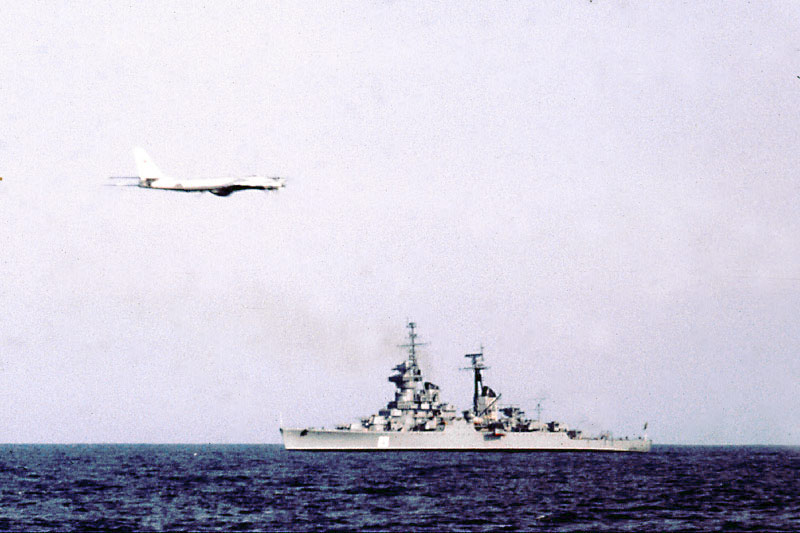
Soviet naval might: Sverdlov flew over by a TU-95 Bear naval bomber in April 1975
Instead, Kruchtchev, well advised by the new head of the Soviet admiralty, had less ambitious plans, but more practical and a realistic, a pragmatic approach for innovative solutions to deal with the US Navy supremacy, rather than trying to cope in numbers on the same level. This became the first steps for a new policy focusing on missiles which endured until the 1980s. Of this total of twenty, two of these cruisers never even reach the launching stage, being canceled and broken up along the way, and four more were never completed and remained anchored in the Neva estuary in Leningrad until 1961. Only 14 cruisers were finally completed between 1952 and 1955. This still makes it the largest cruiser class in the history of the Soviet Union or Russia for that matter. As conventional cruisers, they caused some concerns to the West, especially Britain, which struggled with its own postar budget cuts to keep at least six operational cruisers and up to the task as we saw with the Tiger class cruisers.
Development
Stalin’s plan for 50 cruisers
The Sverdlov class cruisers were the last soviet conventional cruisers. They succeeded the Chapayev launched at the beginning of the Second World War. At the end of the Second World War, Joseph Stalin indeed planned a major modernization and expansion of the Soviet Navy. The prewar plan, cimpletely shattered in the summer of 1941 was to obtain a blue-water navy able to display its strenght on the Pacific, Mediterranean and Atlantic. Large numbers of cruisers were required, as escorts of heavier ships (battleships and then battlecruisers planned at the time) and lead destroyers.
As speed and mass production was the essence, to cut down the design phase to the minimum it was decided to take the pre-war Chapayev-class (Project 68) as a base. They were to be improved in all area but keep the same basic caracteristics, notably their armament. The result was Project 68B. This choice was done instead of a wholly new design, called Project 65. For more see WW2 Soviet cruisers. The design for the Sverdlov class was approved on 27 May 1947 after some back-and-forth proposals. Initially Stalin wanted to order 30 Sverdlovs but budgetary contraints cut this to just 5 in order to fund the three Stalingrad-class battlecruisers, that he wanted most. Some authors included the 30 ordered included the five Chapayevs. In fact, both classes were so intertwined that the first three ships were named after canceled ships of the previous Chapayev class.
In January 1947, the tactical and technical assignment (TTZ) was issued for the development under the code “68-bis”, carried out by TsKB-17 under chief designer A. S. Savichev. In addition to retake the Chapayev class, to save more time, the draft project was abandoned, and the final design was approved five months later. In 1949, at the request of the Navy staff, the project was revised for the installation of new radar stations and communications equipment, notably those of the Pobeda system.
New Challenges, and all-welded construction
The development of the project “68-bis” was the result of almost 15 years of work by TsKB-17 to create cruisers and largely the result of A. S. Savichev with chief Navy observer Captain 1st rank D. I. Kushchev. That developed was carried out simultaneously with the completion of the cruisers started prewar, which keels had already been laid in 1939-40. Project 68-K (Chapayev class) was chosen as prototype but largely revised as the first post-war project and taking in account the latest war lessons and evolutions of technology, and what was now unlocked for Soviet shipbuilding. The project was one of a brand new generation of combat ships which took on design stage as much as possible of post-war scientific and industrial developments. The best symbol of that was the choice of an all-welded construction using a new low-alloy steel instead of riveted construction, a great step in efficiency, weight reduction and reduced costs.
In the 68-bis project the Baltic Shipyard was entrusted to manage the welding of thick and very large armor plates. This was mastered under A. P. Goryachev coupled with a new technology for section assembly of the welded hull from large block sections weighing 100-150 tons each. At the same time, armor plates were fully included in the hull’s structure as integral of its of load-bearing, something inspired by Japanese naval construction in the interwar. But all depended of a new low-alloy weldable steel classed as a grade SHL-4 (yield strength 40 kgf/mm²). Electric welding was still in 1947 a complex technological process, and it carried out only due to the nomerous studies made in 1945-1948, helped by technologies mastered by Shipyard German specialist engineers, also brought to the USSR in 1945 and an aspect neglected by the West. German shipyards indeed mastered that construction already in 1926 for the K class cruisers.
Thus, in combination with Soviet experience in the use of welding thick armoured plates for tanks, emerged as a winning combination for this undertaking in naval construction. This new technological process of assembling a welded hull compared to a riveted one, made possible of course not only to reduce construction time of almost half so down to two years up to two and half, but also to save a lot of displacement weight (just as the armour being part of the structural strenght) and avoid weak points in the hull. WW2 had shown indeed how many times near misses could cause plating rivets underwater to popup and cause flooding…
Death of Stalin and consequences
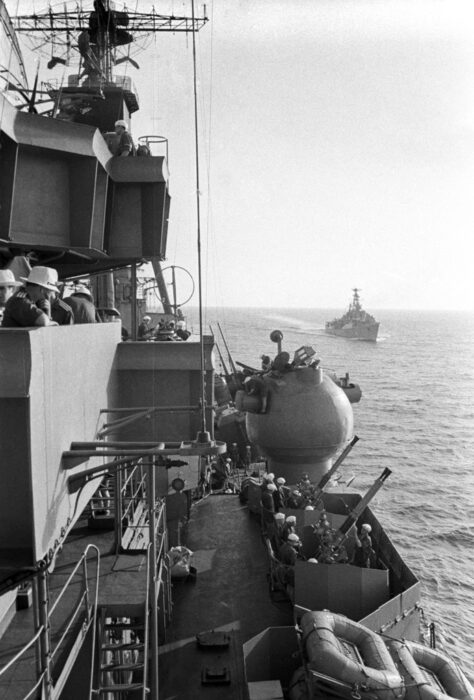
RIAN archives, premier Nikita K. aboard the cruiser Dmitry Pozharsky
The death if Stalin was a sismic event in USSR due to the enforced cult of personality. But for the military, and especially the Navy, this was a relief. In 1953, the order fro 30 cruisers and all other heavy ships projects like the Stalingrad class was cut to 21, which was still important. Arbitration between the old guard and younger staff members which pushed for missiles ended with a victory of the traditionalists, that maintained that as long the USN maintained its WW2 cruise fleet the Soviet Union should have some. Arguing also that missile programs, despite Operation Osoaviakhim (smuggling German scientists into USSR in 1945) would take time to bear fruit. The Navy needed at least an interim. Other programs also depended on these cruisers such as the mass-built Skoryy class which needed leaders.
The first 15 hulls were laid down and at some point the Soviet Navy decided to have the remaining six hull completed to a modified design called Project 68zif (see later) which were basically an improved NBC version, complete with with provisions for protection against nuclear fallout and modularity as command ships, even hybrid missile ships, albeit none was completed.
Plans were further developed and new drawings produced to upgrade the Project 68zif, in order to carry cruise missiles but they were dropped as the new
construction of the Kynda class missile cruisers was approved. These were canceled in 1959. The incomplete hulls just were mothballed and rusted away until stricken and BU in 1961. Except Admiral Kornilov which became a test hulk for experiments and lingered a bit longer. The Kynda were small cruisers dedicated to carry such cruise missiles, way smaller and cheaper to built maintain. They were at the base of future programs, the Kresta I, II, Kara, Slava and Kirovs that defined the cold war.
While the younger Naval staff pushed for more missile cruisers, and a reduction in the conventional cruiser force, some in Soviet Navy leadership, many of which were WW2 veterans, and the Politburo, insisted that cruisers could act as command ships for naval gunfire support in amphibious operations, and make a statement by showing the flag. It must be stressed out that in 1960 the US still had a healthy number of operational cruisers, among which the relatively recent and comparable Worcester class and especially the mighty Des moines class, plus a number of modernized Clevelands and Bostons. Showing the flag with such cruisers was indeed more impressive than new, small missile cruisers. They were seen as ideal to lead a political presence in contested areas of the Third World such as Cuba and Indonesia (which obtained Kri Irian by the way as a mark of friendship). Many deplored that in 1962 during the missile crisis more Sverdlovs were available, they would certainly have been deployed to escort merchant vessels. There were even plans to send Chapayev class cruisers in Cuban ports to guarantee the island against possible future blockades.
But by 1962 also the younger staff faction argued these cruisers were were now completely outclassed as surface combatants, doomed by having no missiles of protection against these. By their very nature, they could only received limited modernizations in the 1970s and they were only kept as potential naval gunfire support platforms. When gone, this motivated the naval staff to ask for gun-armed replacements, such as the Sovremenny class destroyers.
Standard Soviet practice to spare funds was to keep these ships reserve status, with a crew of reservists trained if needed. They were relegated to reserve status by the early 1980s and lingered until the end of the cold war.
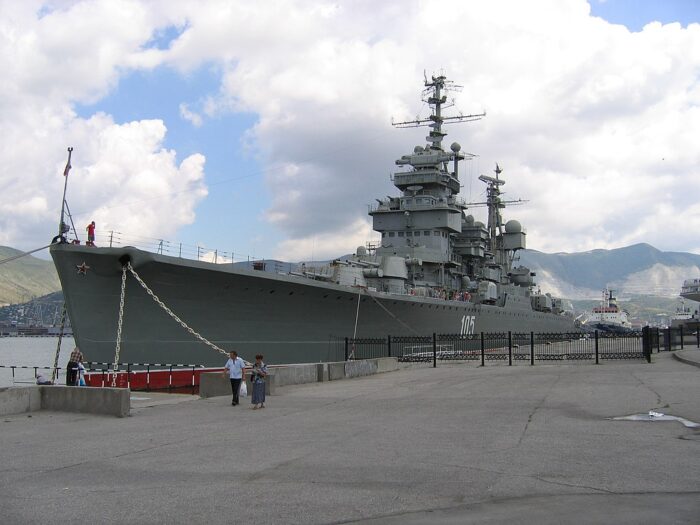
Mikhail Kutuzov is the only survivor of this era, and only conventional russian cruiser outside Aurora in St Petersburg, now a museum ship in Novorossiysk.
Design of the class

Projekt 70E Sverdlov rear
The Project 68-bis in comparison with Project 68-K (Chapayev) saw a radical increased in displacement and dimensions, extended forecastle, improved habitability and slight increased power as well as more auxiliary power (diesels to feed electric systems aboard), but also a larger anti-aircraft artillery with rowrked acrs of fire. The use of better fire contrl, all radar guided was also completely new, plus new optical aiming systems, also inspired by German technology. This was obvious notably in the “bowl” type radars family. The design was tailored also to receive more modern navigation, communucation and weapons management systems. The ships needed a longer range and had an increased autonomy up to 30 days with a cruising range specified as at least 9,000 miles. Project 68-bis was the “base project” for modifications such as Project 70-E and the command ships Projects 68-U-1 and 68-U-2 in the 1970s, as a way to keep these active.
Hull and general design

The Sverdlovs in many ways recalled the Chapayevs, but with a greater (oceanic) autonomy thanks to larger hull dimensions for more generous oil tanks. They also had a better overall protection, and a double hull on 75% of their length, plus 23 watertight compartments. The hull was of a completely welded new design, albeit in shapes, they recalled the Chapayevs, with the same general layout. These cruisers inaugurated new radars and fire control systems, as well as new 100 mm mounts for their secondary batteries, copied from the German dreaded 88 mm Flak battery, also used on the Skoryy class destroyers. The 152 mm (6 inches) main turrets were improved versions of the Chapayev. The final, revised design adopted in May 1947 showed impressive ships indeed.
They displaced 13,600 tons standard, 16,640 tons at full load for 210 metres (689 ft) long overall, 205 metres (672 ft 7 in) at the waterline for a beam of 22 metres (72 ft 2 in) and a draught of 6.9 metres (22 ft 8 in).
Typical complement in their initial form rose as high as 1,250, which was battleship-like in scale. Autmation was a long way away. All the artillery was human-manned, as well as the control systems and radars.
By some aspects they also recalled the contemporary Swedish Tre Kronor class cruisers with the same forecastle running for 2/3 of their lenght and lowever deck, rounded poop, and tall tower like bridges. But they were twice as light. The Sverdlovs were in line with previous designs such as the Kirov class of the 1930s with basically a great input of interwar Italian design in their DNA. This was showed by their two large funnels far apar, tripod masts and tall, tower like bridge supporting their main fire control systems. The bridge was composed of a lower three levels high command part with the main bridge surrounded by an open balcony, which sat above the main conning tower. It is interesting to note that contrary to the USN that saw already in 1941 the conning tower as a waste of weight and were disposed of the design of their cruisers, Soviet engineers persisted in the idea.
The beam profile was interesting, calculated for the least pitching motion, with its greater beam located at 2/3 of the lenght aft, at the level of the rear AA artillery platform structure and just before the X-Y turrets.
They also had entirely wooden decks all along and two anchors forward. The poop deck was singular as they retained their mine carrying capability, like the Skotyy class destroyers, using two set of rails on both sides, with interconnection just aft of “Y” turret and another aft, then a connection from double to single track just before the poop chutes. They had only six boats to save their crew: The main four were located between the forefunnel and Two staff speedboats, and two pinnaces, one between them and one transverse. They were managed by the boom crane anchored on the main mast. There were also two yawls under davits on the rear deck, abaft “Y” turret.
Protection
The Sverdlov were well protected for “light” cruisers. They took the previous Chapayev’s scheme as a base and improved on it. The goal was to ensure some partial immunity against 6-inches shells. Here are the details:
-Main belt: 100mm (4 inches) over 3.3m high
-Outer belt 20mm (0.8 in) belt between the citadel and ship ends.
-Bulkheads, citadel between end barbettes: 120mm (4.7 in) fore and 100mm (4 in) aft
-Flat main armoured deck 50mm (2 inches), connected with upper edge of the main belt
-Outer armoured deck at both ends: 20mm (0.8 in).
-Steering gear compartment: 100mm (4 inches) sides, 20mm (0.8 inch) roof.
-Conning Tower 130mm (5 inches) sides, 100mm (4 inches) roof, 30mm (2 inches) deck
-Secondary (aft) CT: 10mm (0.4 in) protection.
-Main turrets: 175mm (6.8 inches) faces, 65mm (2.5 in) sides, 60mm (2.4 in) back and 75mm (3 in) roofs.
-Main Barbettes: 130mm (5 inches) armour.
-Secondary turrets: 20mm (0.8 in) faces, sides, rear, 10mm (0.4 in) roof, 20mm barbettes.
And as said above, the hull was all-welded, with a double hull and 28 watertight compartments enclosed by bulkheads below the waterline and armoured deck.
Powerplant
The Sverdlovs had two propellers shafts, driven by two geared steam turbines, fed by six boilers and generating 118,100 shaft horsepower (88,100 kW). Top speed was 32.5 knots (60.2 km/h; 37.4 mph) in the right conditions, which was fast indeed. In addition and as specified, helped by their larger hull, they had a range of 9,000 nautical miles (17,000 km; 10,000 mi) at 18 knots (33 km/h; 21 mph), perfect for long oceanic commere raiding missions or overseas deployment in the third world. To compare, the Chapayevs had 110,000 shp (82,000 kW) for 35.6 knots but only 7000 nmi range at 19 knots.
Armament
Very much a WW2 Chapayev class scheme, the Sverdlovs were still better armed, notably regarding AA.
-They had the same triple 15.2 cm (6.0 in)/57 calibers, but these were B-38 guns in Mk.5-bis turrets with better elevation for AA fire. They were mounted in two superfiring pairs fore and aft, A-B and X-Y.
-This was completed by their secondary artillery made of six twin 10 cm (3.9 in)/56 caliber Model 1934 guns in SM-5-1 mounts. The guns were old, but the mounts were brand new wheeras the previous Chapayevs had only four twin prewar 100 mm (3.9 in) B-54 guns.
-This was rounded for light AA with 16 twin 3.7 cm (1.5 in) AA guns in V-11M mounts, versus 6 twin 37 mm (1.5 in) 66-K AA guns on the chapayevs, so quite an upgrade there too, albeit the Chapayevs had in addition four twin 12.7 mm (0.50 in) DShK-M machine guns, completely outmatched by modern Jets. They were completely omitted from the Sverdlovs.
-In common, the two class had torpedo tubes. But instead of two triple banks, the Sverdlov had quintuple 533 mm (21 inches) torpedo tubes in PTA-53-68-bis mounts. So that was another considerable upgrade. In time these tubes could fire ASW heavyweight torpedoes as well. More details below.
B-38 guns/Mk5-bis turrets

By 1940 standards, the B-38 had a a good rate of fire, survivability and heavy projectile with excellent ballistic characteristics for its caliber and time. However, by the standards of the 1950s, as Project 68K and 68-bis entered service, they left much to be desired. The main drawback was now a low rate of fire due to the separate cartridge loading system.
Western fleets had cruisers with much more rapid-fire guns notably the Worcester-class light cruisers and their semi-automated Mark 16 at 12 rpm of the British Tiger-class and their Mark V capable of 20 rounds per minute. The Swedish Tre Kronor class and Dutch De Zeven Provinsen had the same models capable of 10 rounds per minute, and they all had better elevation angles for anti-aircraft fire. The B-38 was thus designed to surpass its Western counterparts in range and fire control.
The revised cartridge system made it possible to fire with incomplete charges to reduce barrel wear, which came in handy for practice, while a good range was essential for shore bombardment. The gun was indeed primarily used for fire support and cover landings notably for the Project 68-bis cruisers. This artillery was also made to to neutralize American aircraft carriers or just do some intimidating presence.
⚙ specifications B-38 |
|
| Weight | 11,999 kgs barrel |
| Barrel length | 152.4mm for 8935/58.6mm, bore 8690/57 mm |
| Elevation/Traverse | -5°/+45 at 13°/s, traverse 360° at 7°/s |
| Loading system | Breech type piston |
| Muzzle velocity | 800 — 950 mps |
| Range | 30,215 m |
| Guidance | |
| Crew | 57 — 63 |
| Round | 48.5—55 kgs, 176—186 rounds per barrel |
| Rate of Fire | 6.5 — 7.5 rpm |
MK-5 Mount and MK-5bis: 242,821 and 253,400 kgs. Barrel sweep radius 8,750 mm, distance between gun axes, 1,450 mm
10 cm Model 1934 guns/SM-5-1 mounts
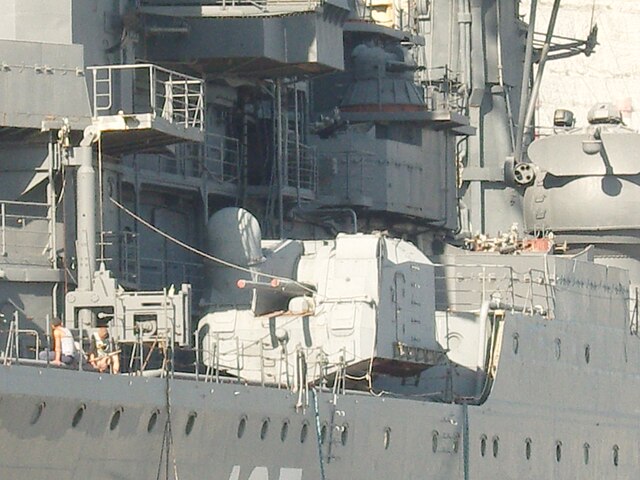
The SM-5-1 system was developed at TsKB-34 in 1943-1947, tailored for the Project 68K (Chapayev class) cruisers. The prototype was completed for trials at the Bolshevik plant in 1947 with tests conducted from July 22 to November 5, 1948 at the Rzhev proving ground. It was accepted into service on May 11, 1949. Production went on from 1948 to 1955 at the same plant, in the SM-5-1 and SM-5-1s versions, 150 mounts total.
The SM-52 mount was later designed on the same ammunition but not adopted. Both barrels of the mount were placed in one cradle with a wedge-type breech and manual loading but pneumatic rammer. There was a horizontal stabilizer with automatic control. The centralized fire control usied the Zenit-68bis A system fed data by the Yakor artillery radar but they still could fire under local control with optical rangefinders and Shtag-B radio rangefinders if needed.
⚙ specifications SM-5-1 mounts |
|
| Mount Weight | 45,8t, including 10—20 mm armour, barrel 3,972 tons |
| Barrel length | 7015mm/70, 4,800 mm radius, recoil 586 mm |
| Elevation/Traverse | −8 to +85 16°/s; 360 at 17°/s. |
| Loading system | Manual, with pneumatic rammer |
| Muzzle velocity | 1000m.sec. |
| Range | 24,198 m, 17,000 m ceiling |
| Guidance | Fire control radar, optical backup |
| Crew | 19 |
| Round | 15.6kgs (HE), 15.9kgs (anti-aircraft), 341 rounds per barrel |
| Rate of Fire | 18 rpm max |
37 mm V-11M mounts V-11
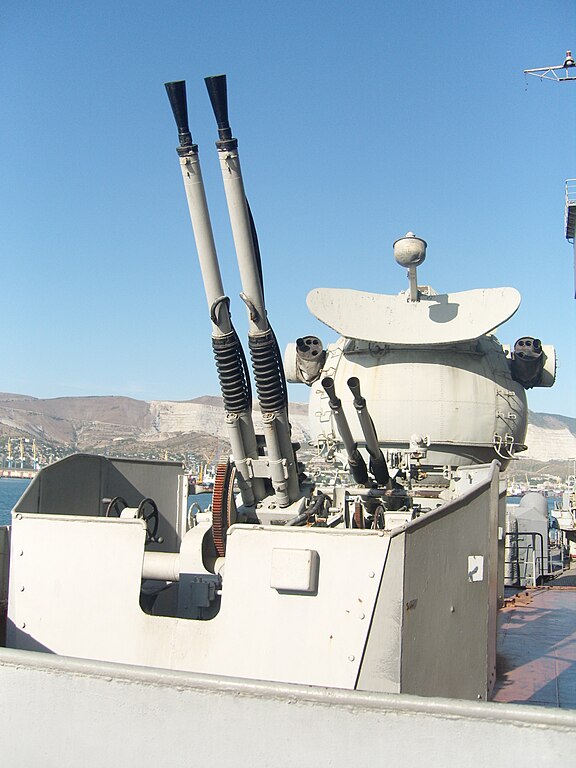
This weapon was designed on the basis of the 70-K artillery mount in service with the Soviet Navy in WW2. The design of the V-11 started with ANIMI in 1940 with state ship trials conducted on the “Shturman”, Northern Fleet in the summer of 1944. The V-11 was accepted into service on July 25, 1946 with later minor design changes leading to the V-11M which production lasted until 1957, 1872 delivered total. The twin cradle used 70-K guns featuring a monoblock barrel with forced water cooling, vertical wedge breech, manual aiming in elevaiton and traverse, optical targeting, unstabilized and fed by clips of 5 rounds manually. It fired a frag-tracer 732 g (36 g of explosive) or armor-piercing tracer 758 g without explosive and fuse.
⚙ specifications 37mm B-11 |
|
| Weight | 65 kgs barrel, mount 3,16t with 6 mm protection |
| Barrel length | 37mm 67.5 calibers. |
| Elevation/Traverse | -10/+85° at 12.6°/sec.; 360° at 16.4°/sec. |
| Loading system | Vertical wedge breech, 5 rds clips, manual |
| Muzzle velocity | 880 m/s |
| Range | 8400 m, ceiling 4000 m |
| Guidance | Optical |
| Crew | 10 |
| Round | 732g HE or AP |
| Rate of Fire | 180 rpm |
2×5 PTA-53-68-bis torpedo mounts
Two quintuple banks located relatively close to the bridge, behind the full beamm shoulders supporting AA mounts. It’s not known if they were reloadable. When delivered in 1953, these cruisers likely had the 1951 53-51 torpedo, a simple, fast and dependable model and modification of the 53-39 torpedo with a maneuvering device and new active magnetic fuse. They were not upgraded with the 53-56, 53-56V or SET-53/SET-53M or 53-61 “Alligator”/53-61M homing models as torpedo tubes were landed during modernizations to spare top weight.
⚙ specifications 53-51 torpedoes |
|
| Weight | 4,134 lbs. (1,875 kg) |
| Dimensions | 299 in (7.600 m) |
| Propulsion | Kerosene-air wet heater |
| Range/speed setting | 4,000 m/51 kts or 8,000 m/39 kts |
| Warhead | 661 lbs. (300 kg) |
| Max depth | Limited |
| Guidance | Non-homing |
Sensors
The cruisers radar suite comprised the following:
-‘Big Net’ or ‘Top Trough’ air search radar
-‘High Sieve’ or ‘Low Sieve’ air search radar
-‘Knife Rest’ air search radar
-‘Slim Net’ air search radar.
-‘Don-2’ or ‘Neptune’ navugation radar.
-Two ‘Sun Visor’ fire control radars
-Two ‘Top Bow’ 152 mm gun radars
-Eight ‘Egg Cup’ 1mm/37mm gun radars.
-‘Watch Dog’ ECM systems as for Electronic countermeasures but later modernized.
Note the history of modifications below.
⚙ Sverdlov specifications |
|
| Displacement | 13,600 tonnes standard, 16,640 tonnes full load |
| Dimensions | 210 x 22 x 6.9m (689 x 72 ft 2 in x 22 ft 8 in) |
| Propulsion | 2× shaft TV-7 geared steam turbines, 6× KV-68 boilers, 110,000 hp (82,000 kW) |
| Speed | 32.5 knots (60.2 km/h; 37.4 mph) |
| Range | 9,000 nmi (17,000 km; 10,000 mi) at 18 knots |
| Armament | 4×3 15.2 cm/57, 6×2 10 cm/56, 16×2 3.7 cm guns, 2×5 533 mm TTs |
| Protection | Belt 100 mm, CT 150 mm, Deck 50 mm, Turrets 175 mm, Barbettes 130 mm, Bulkheads 120 mm |
| Sensors | Sea Gull, Knife Rest A, Slim net, Top Bow, Egg Cup, hull passive sonar |
| Crew | 1,250 (1955) |
Evaluation of the Sverdlov class
The Soviets originally planned to build 40 of these cruisers, and work woth the Stalingrad-class battlecruisers plus projected aircraft carriers. Stalin originally specified, in accordance to the naval staff, ships tnhat can support the defense of the Soviet coastline, operating worldwide with limited support and protect the Arctic, Baltic, Mediterranean and Black Sea interests but also commerce raiding, or just political presence in the Third World. This wa slater reverted by Nikita Khrushchev and the General Staff, but these ended as a real threat to the British and Dutch navies, which lacked day/night carrier capability before satellite surveillance. In Britain in particular, knowing that Uncle Sam would not be always present if such Soviet ships started to prey on its trade, these cruisers remains a powerful concern.
The Royal Navy used this threat as leverage to justify in the budget-stripped postwar years to maintain a conventional fleet of cruisers and aircraft carriers, notably enough for rotations in the North Atlantic. One of the assets that was developed to counter these cruisers was the Blackburn Buccaneer, a carrier-based strike aircraft designed to approach under the radar, and attack Sverdlov-class cruisers with ordinary bombing or tactical nuclear ordnance with enough velocity to remain beyond the range of their Soviet 100 mm (3.9 in) and 37 mm (1.5 in) artillery.
However as Stalin’s program was cut back post-1953 plus battlecruisers and carriers cancelled, the Sverdlovs were largely less protected when operating, and now as commerce raiders, USN carrier battle groups plus Baltimore and Des Moines-class cruisers heavy gun and protection could compensate for the Royal Navy’s last Fiji and Tiger-class cruisers whih were ouclassed and outrun by the Sverdlovs. The end result were in 1954, 14 hulls had been already completed, with two additional hulls scrapped on slip, four partially complete scrapped in 1959. Even a part of those completed were not fully operational and mothballed until scrapped in 1961. Due to other priorities these “flagships” as justified by the naval staff had only limited modernizations managing to keep these more or less relevant until late 1980s.
The final Sverdlov class was far less impressive than initially planned, comprising the fully completed Sverdlov, Zhdanov, Admiral Ushakov, Admiral Senyavin, Alexandr Suvorov, Dmitri Pozharski, Ordzhonikidze, Alexandr Nevsky, Admiral Lazarev, Dzerzhinsky, Admiral Nakhimov, Mikhail Kutuzov, Oktyabrskaya Revolutsiya, and Murmansk. They were equitably divided among the four fleets.
Some of these ships were then converted (as the Americans had done) into missile cruisers. Thus, Admiral Nakhimov was rebuilt barely two years after entering active service as an anti-ship missile cruiser, equipped with AS-1 missiles, then SS-N-1 “Scrubber” missile, using a replacement launcher at the same time. She also kept half the turrets. This conversion proved a disappointing one, and the ships was eventually used as a target and then scrapped in 1961.

Dzerzhinski was equipped instead of three turrets and a SA-2 “Guideline” SAM was installed. It was a navalized version of the land launcher. This time the conversion proved a success and she had a long active career, being retired in 1989.
Zhdanov and Senyavin served as command ships, being completely rebuilt in 1970-72 in this role. They received a lattice mast supporting very powerful Vee Cone antennas, satellite relay, the whole rear part being converted into a flight deck for three ASW helicopters, complete with a with hangar, and a retractable missile launcher SA-N-4 “pop-up” plus antimissile superfast 30mm guns.
Revolutsiya, Ushakov and Suvorov received a new enlarged footbridge and more modern electronic equipments in 1977-79, yielding their 3 7mm guns and Egg Cup firing control systems for four 30 mm missile-controlled guns by NATO “Drum Tilt” system.

Orzhonikidze was sold to Indonesians in 1962 as KRI Irian. She Sold for scrap to Taiwan in 1972. Nakhimov was written off in 1961, the others in 1987-89. There were still three of these cruisers in service in 1990: Suvorov, Senyavin, and Murmansk. They were retired in 1990-92, with no budget and no use to support them.

Author’s rendition of the Sverdlov class
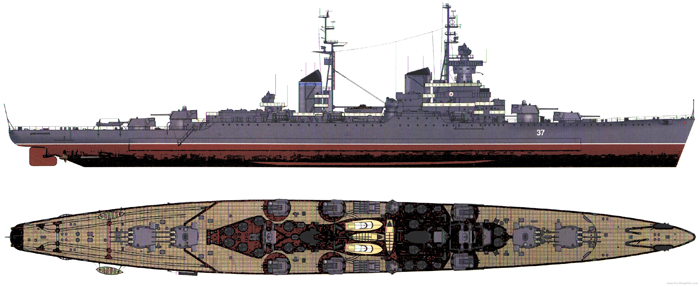
The livery of Dzherzhinsky in 1954: Pine decks, dark red serrated metal decks, dark red hull, white waterline band and medium gray vertical surfaces, white canvas, white ID number (which changed very regularly), a red star painted close to the bow and another painted over a white roundel on either bridge’s wings. Some also had funnels unit markings, such as here, a blue ribband around the aft funnel. The name of the ship was written in dark red in relief on the poop, with white outlines.
History of Modernizations
“Regular” Upgrades:
In 1953 had its Yakor radars replaced by modernized Yakor-Ms and the next year Admiral Nakhimov (project 68E) had her two aft turrets removed, as well as two 100mm/70, and two 37mm/70 mounts ffor the addition of a single KSShch SSM (1 KSS) antiu-ship missiles for trials. The same year Dzerzhinskiy tested the Korall ECM suite. In 1955 Admiral Nakhimov underwent project 68ER upgrade with its V-8 launcher replaced by a V-16 launcher. Unde rproject 67EP this was the V-16E launcher.
In 1956-57, the P8 radar was installed on Mikhail Kutuzov, Dmitriy Pozharskiy and Molotovsk and the Krab ECM suite in 1956 on Admiral Senyavin, Dzerzhinskiy and Zhdanov, the nexy year for Admiral Ushakov and in 1961 for Dzerzhinskiy. The remainder had it installed up to 1976. Bteween 1958-1962 they all had their TT removed as well as the associated Zaria radar.
In 1958, Aleksandr Nevskiy and Dmitriy Pozharskiy received the P-500 Kliver radar, which started to be installed on other units until 1962.
In 1961 Sverdlov was the first to see the replacement of her Rif radar for the Fut-N.
In 1958-1967, Admiral Senyavin, Dmitriy Pozharskiy, Admiral Ushakov, Aleksandr Suvorov, Murmansk and Sverdlov received the P-10 radar, the latter in 1966 was equipped also with the Kil’-U radar and in 1967-69 Mikhail Kutuzov and Oktyabrskaya Revolyutsiya also received the same and the P-10 radar. In 1969-1970, Admiral Senyavin, Aleksandr Suvorov and Dmitriy Pozharskiy were upgraded with the P-12 Yenisey radar and in 1969-1970, Admiral Ushakov, Oktyabrskaya Revolyutsiya, Murmansk, Sverdlov and Mikhail Kutuzov had their P-10 radar replaced. Admiral Lazarev lost six 37mm/70 AA guns and received a P-20 radar in the 1970s.
Refit and modernization completed by August 1962, saw Dzerzhinskiy lost her “X” main gun turret as well as eight 37 mm mounts, torpedo tubes, Zalp and Zaria radars. She received aft a twin M-2 Volkhov SAM (10 V-750) missile launched, plus the P-500 Kliver, Fut-N, MR-200 Kaktus, and Razliv radars. Dzerzhinsky was now an hybrid conventional cruiser with a surface-to-air missile (SAM) launcher for the M-2 Volkhov-M missile (SA-N-2 “Guideline”), a conversion considered to be unsuccessful, and not extended to other ships. The entire missile installation was above the armored deck whereas the S-75 Dvina was liquid-fueled with acid/kerosene, a serious hazard if hit. Final displacement rose to 12,970 tonnes standard and 16,070 tonnes fully loaded and her draught went down to 7.2m. Range was reduced to 7400 nm at 17 knots.
Project 68U1:
Zhdanov lost her X turret as well as her Giuys-2 and Neptun radars for a twin 4K33 Osa-M SAM (20 9M33) launcher and four 30mm/71 AK-230 CIWS, and the Kil, Don, 4R-33, and MR-104 Rys’ radars as well as the Planshet CCS for a fully loaded displacement of 14,340/17,890t, 7.8m draught and 5800 nm range.
Project 68U2:
1966-7-1972 saw Admiral Senyavin modernized with the same scheme, X turret removed and the same radars, same Osa-M SAM launchers but eight 30mm/71 AK-230 CIWS and a landng pad aft for a Ka-25 helicopter. The electronics suite included the Kil’-U and MR-302 Rubka, Don radars as well as the FCS radars 4R-33, MR-104 Rys’ and same Planshet CCS.
Displacement rose to 14,350t standad and 17,890t FL, at 7.8m draught, 6940(18)nm range. With autmation the crew fell to c850.
Zhdanov and Senyavin were converted as command ships and also gained extra accommodations. Close protection was ensured by a safer 4K33 “Osa-M” (SA-N-4 “Gecko”) SAM system. Senyavin had her “Y” turret removed as well for her helicopter deck and hangar. The Kamov Ka-25 was used for liaison to shore.
Project 68A:

In 1972-1976 Oktyabrskaya Revolyutsiya and in 1973-1979 Aleksandr Suvorov underwent this upgrade, lossing four 37 mm AA mounts, as well as their Giuys-2 and Neptun radars. In exchange their received eight twin 30mm/71 AK-230, as well as the Kil’-U, Don, four MR-104 Rys’ FC radars, and Machta-P4, Machta-P10 ECM suites. Displacement was the largest in class, at 14,600 tonnes standard and 18,090 tonnes fully oaded, a 7.8m draught and range down to 6450 nm. In 1978 Admiral Ushakov underwent the same upgrade, without loss of her main artillery. The last upgrade this way between 1979 and 1986 was Mikhail Kutuzov. Oktyabrskaya Revolyutsia had an enlarged bridge in 1977 as a trial, and Admiral Ushakov and Aleksandr Suvorov followed in 1979, then Mikhail Kutusov later.
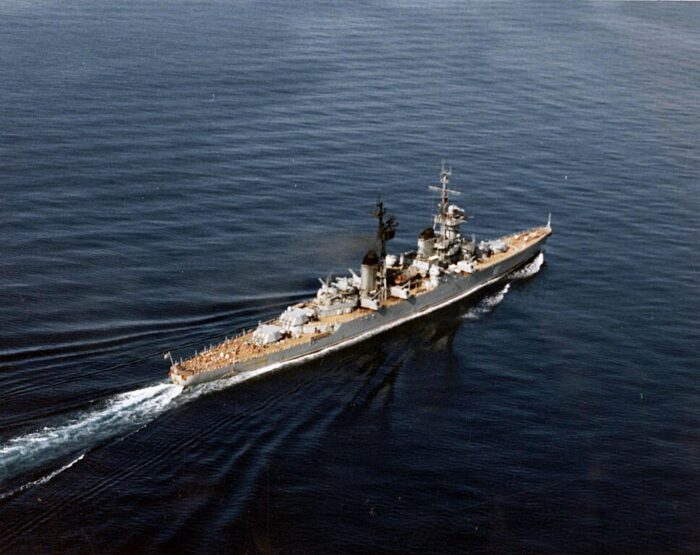
Sverdlov in 1974.
⚙ Project 68A specs 1980 |
|
| Displacement | 14,600 tonnes standard, 18,090 tonnes FL |
| Dimensions | Same but 7.8m draught |
| Speed | 32 knots (60 km/h; 37 mph). |
| Range | From 6,450 nmi at 18 kts |
| Armament | 4×3 152 mm (6 in), 6×2 100 mm(4 in) AA, 8x 30mm/70 CIWS. |
| Sensors | Kil’-U, Don, 4x MR-104 Rys’ FC, Machta-P4, Machta-P10 ECM |
| Crew | c890 in 1980 |
Career of the Sverdlov class
 Sverdlov
Sverdlov

Sverdlov (Свердлов) was laid down at the Baltic Shipyard in Leningrad on 15 October 1949, launched on 5 July 1950 and completed on 15 May 1952. She was named after Yakov Sverdlov, a Jewish Bolshevik party leader.
On 31 August 1952, she entered the 4th Navy. From 7 to 18 June 1953, she visited to Portsmouth for thecoronation of Queen Elizabeth II. From 12 to 17 October 1955 she was again at Portsmouth and by 24 December 1955 she was transferred to the Baltic Fleet. From 20 to 25 July 1956 she visited Rotterdam. From 24 December 1960 to 14 July 1961 ad well as between 12 February to 29 April 1966, she had a major overhaul in Leningrad. After that she decommissioned and mothballed but reactivated on 11 February 1972. From 5 to 9 October 1973, she visited Gdynia in Poland and on 16 to 22 April 1974, she visited Algeria, then from 21 to 26 June 1974, Cherbourg in France. From 27 June to 1 July 1975, she visited Gdynia again and from 5 to 9 October 1976, Rostock in East Germany, then Bordeaux in France, from 21 to 26 June 1976.
On 7 February 1977 she was decommissioned and overhauled and by 14 February 1978, she was mothballed and docked in Liepāja, long-term. On 14 February 1978, Sverdlov was relegated to the reserve and stationed at Liepaya and decommissioned on 30 May 1989.
On 30 May 1989, she was disarmed, decommissioned, stricken on 31 October 1989. In 1990 she was towed to Kronshtadt. and by early 1991 sold to an Indian company. In October 1993 she towed to India, and scrapped.
 Zhdanov
Zhdanov
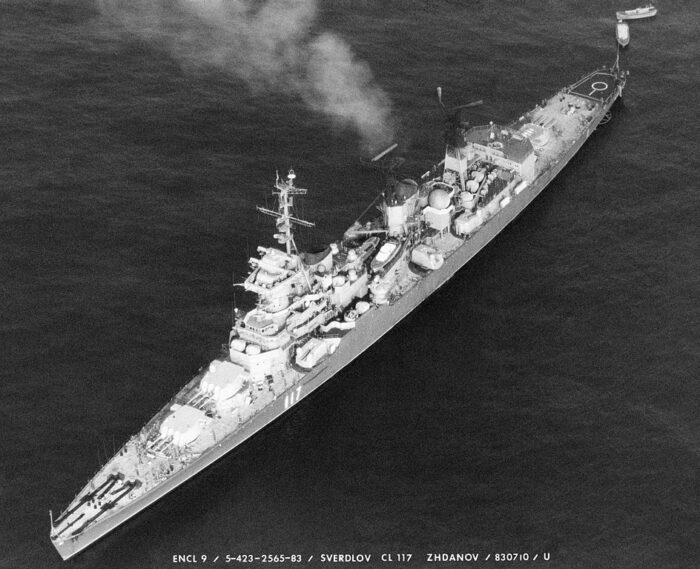
Zhdanov (Жданов) was Named after Andrei Zhdanov. She was laid down at the Baltic Shipyard in Leningrad on 11 February 1950, launched on 27 December 1950 and completed on 31 December 1952.
On 25 January 1953, she was part of the 8th task force homeported in Tallinn. On 25 January 1954 she was visited by CiC Admiral N.G. Kuznetsov. On 24 December 1955, she was officially transferred to the Baltic Fleet.
At some point (see upgrades) she was was converted into a Project 68A command ship: Her “X” turret was removed and replaced by office space plus extra communication and electronics equipments added. In September 1988 she took part in the exercises of the Black Sea Fleet “Autumn-88” under Captain 1st Rank A. Rimashevsky. On 21 February 1989, she was stricken, listed instead as “KRU 101”. On 10 December 1989, she was re-registered as the command cruiser Zhdanov. On 19 April 1990, she was disarmed and transferred to the sale list. In February 1991, her crew was disbanded and she was sold for scrap, towed on 27 November 1991 by the tug Shakhtar to the port of Alang, India.
 Admiral Ushakov
Admiral Ushakov
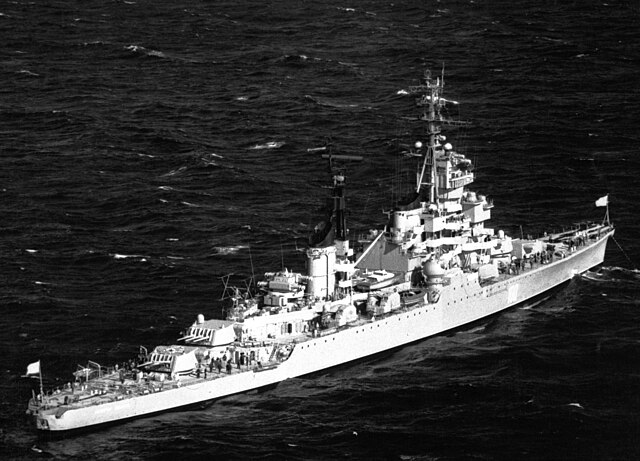
Admiral Ushakov (Адмирал Ушаков) was named after Fyodor Fyodorovich Ushakov, …. She was laid down at the Baltic Shipyard in Leningrad, 31 August 1950 launched on 29 September 1951 and completed on 8 September 1953.
On 19 September 1953, she entered the 8th Division and from 16 to 21 April 1954, she visited Stockholm. In 1955 she won the prize of the CiC for artillery markmanship. On 24 December 1955, she transferred to another fleet and on 3 November 1956, transferred again to the Black sea Fleet. In 1957, she tested take-off and landings on a specially created helideck at the poop. She was the first to do so and by the 1970s had a non-permanent Ka-25 helicopter.
From 19 to 22 October 1973, Admiral Ushakov she visited Messina and from 7–10 August 1981, Varna in Bulgaria. On 28 February 1983, she was decommissioned, placed in reserve, mothballed in Sevastopol. On 16 September 1987, she was disarmed and stricken and by 1992, sold for BU and scraped in India.
 Aleksandr Suvorov
Aleksandr Suvorov
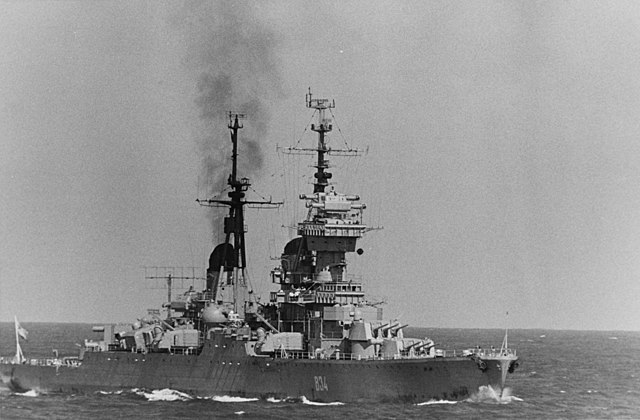
Ushakov in Okean 70 in April, Philippines.
Aleksandr Suvorov (Александр Суворов) was named after Russian general Alexander Suvorov. She was laid down at the Baltic Shipyard in Leningrad on 26 February 1951, launched on 15 May 1952 and completed on 31 December 1953. On 18 February 1954, she entered the 8th Brigade. From 12 to 17 October 1955, she visited Portsmouth and on 24 December 1955, she was transferred to the Northern Fleet. On 27 February 1956, she was transferred to the Black sea fleet. From 26–31 May 1981, she visited Aden in Yemen. On 1 December 1986, she was decommissioned, mothballed and laid up. On 15 December 1989, she was disarmed and stricken on 19 April 1990, sold for BU in November 1991.
 Admiral Senyavin
Admiral Senyavin

Admiral Senyavin (Адмирал Сенявин) was named after Dmitry Senyavin, Russian admiral during the Russo-Turkish and Napoleonic wars. She was laid down at the Baltic Shipyard in Leningrad on 31 October 1951, launched on 22 December 1952 and completed 30 November 1954.
On 18 December 1954, she entered the 4th Brigade, and 7 September 1955, she was transferred to the Northern Fleet. On 24 December 1955, after crossing the Northern Sea Route from Severomorsk she was transferred to Pacific Fleet. On 17–21 November 1959, she visited Surabaya and betwe, 31 December 1966 and 24 July 1972 she was modernized and rebuilt at Dalzavod in Vladivostok according to Project 68U2 Bukhta-2. She was converted into a command shi with her aft turrets removed and replaced by a helicopter hangar and office space.
On 14–19 January 1973, she visited to Bombay and on 15–20 March, Mogadishu. She was reclassified as a command cruiser and on 20–24 December, visited to Port Louis. On 13 June 1978 as a live-firing test took place she suffered an explosion and fire in “A” turret, killing 37.
On 5–10 November 1979, she visit to Haiphong. On 1 December 1986, she was decommissioned and mothballed and on 30 May 1989, disarmed, stricken on 15 December, and by 1992, sold and scrapped in India.
 Dmitry Pozharsky
Dmitry Pozharsky

Dmitry Pozharsky (Дмитрий Пожарский) was named after patriot Dmitry Pozharsky. She was laid down ar the Baltic Shipyard in Leningrad on 31 March 1952, launched on 25 June 1953 and completed on 31 December 1954, joining the Northern Fleet and by 31 January 1955, the 4th Brigade. On 24 February, she was transferred to the Northern Fleet. On 7 September, she crossed the Northern Sea Route from Severomorsk and was transferred to Pacific Fleet. On 21–26 June 1956, she visited Shanghai and in 1964, cruised with cadets to the Sea of Japan, East China Sea, South China Sea, Philippine Sea and back to Vladivostok through the Sangar Strait. On 29–31 March 1968, she visited Madras and on 3–6 April Bombay, 17–24 April, Mogadishu, 11–19 May, Umm Qasr in Iraq. From 25 May to 2 June she was in Karachi and by 5–9 June, Bandar Abbas, then on 25–28 June, Aden and on 6–11 July, Colombo.
From 25 April 1969 to 23 October 1970, she was in major overhaul at Dalzavod, Vladivostok and in 1971 cruised with cadets with the 1964 route again. From 10 November 1974 to 10 June 1975 she took part in exercises in the Indian Ocean and shadowed the aircraft carrier groyp USS Constellation. She stopped along the way to Madras, Mogadishu, Aden and Port Loui, staying there from February 15 to March 1, 1975 and provided assistance to the population after the tropical hurricane Gervaise.
From June to July 1977, she was involved in naval practice with cadets of the Makarov promotion for a tour of Japan through the Korean Strait, and stopping three days at Sovetskaya Gava, back to Vladivostok through the Kuriles Strait, La Pérouse Strait.
On 30 January 1979, she was overhauled at Dalzavod, Vladivostok and placed afterwards in reserve, then by 5 March 1987, she was decommissioned and stricken on 16 September. In 1990, she was sold for BU and towed in India.
 Ordzhonikidze
Ordzhonikidze
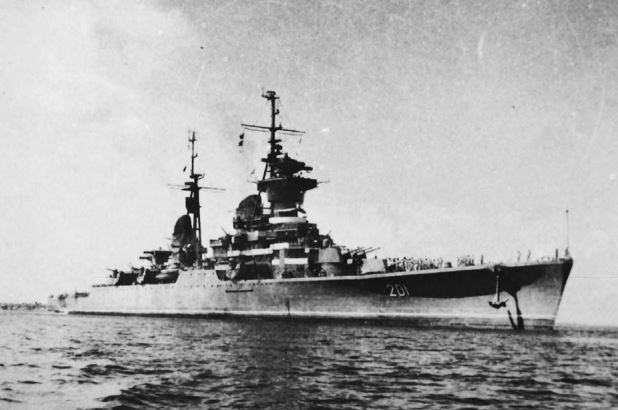
Ordzhonikidze (Орджоникидзе) was frop the Admiralty Shipyard in Leningrad, laid down on 19 October 1949, launched on 17 September 1950 and completed on 30 June 1952. She was broken up in 1972 and named after Grigory “Sergo” Ordzhonikidze, a Georgian Bolshevik. British frogman Lionel Crabb disappeared in 1956 when secretly inspecting this ship for MI6 when it was docked in Portsmouth Harbor.
After a deal to sell the ship to China fell through due to the Sino-Soviet Split, she was sold to Indonesia in 1962, recommissioned KRI Irian in 1963. However there she fell into rapid deterioration due to the absence of maintenance. When she was judged in too poor state for service after years of neglect by Admiral Sudomo as new Chief of Staff of the Indonesian Navy, she was Sold for scrap to Taiwan in 1972.
 Aleksandr Nevsky
Aleksandr Nevsky
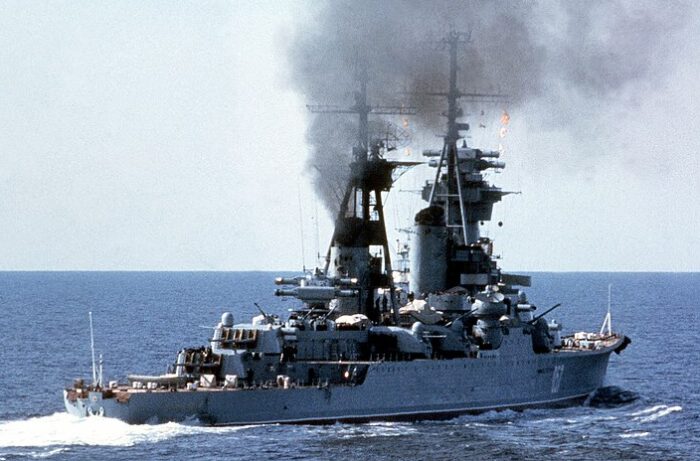
Aleksandr Nevsky (Александр Невский) was from the Admiralty Shipyard and laid down on 30 May 1950, launched on 7 June 1951 and completed on 31 December 1952.
From 1956 to 1962 she was part of the 2nd Cruiser Division in the Northern Fleet.[3] In February 1962, the light cruiser Aleksandr Nevsky was assigned to the newly formed 6th (Missile) Surface Ship Division. On 15 February 1953 she joined the Red Banner Northern Fleet and by May 1953, sailed to eningrad, for a parade in honor of the 250th anniversary of the city. In 1954-1956 she gained all qualifications sea and at the base with cruises in the Arctic Ocean in formation. On 31 March 1956, she sailed with her sisters Murmansk and Oktyabrskaya Revolyutsiya, as part of the 2nd Cruiser Division.
In the summer of 1957, she returned to Leningrad, for Navy Day. Fall 1957, saw her refitted in Leningrad again and modernized at Shipyard No. 194. On 7 November 1957 she represented the Northern Fleet during at the Neva parade, 40th anniversary of the October Revolution. On 25 December 1964 she was decommissioned, mothballed in Kola Bay, Sayda-Guba. In 1968, she was towed to Murmansk for an overhaul and recommissioned on 15 December 1970. In 1988, she was in the movie “Operation Wunderland” as the fictional “Admiral Steiner” (Scheer). On 30 May 1989, she was disarmed and decommissioned, stricken 31 December 1989, transferred to the disposal unit for dismantling with her crew disbanded in January 1990, apart 6 officers still there in the fall of 1990. She was mothballed again in 1991, and by October towed by the tug Dikson, around the the cape to India and Alan Beach near Bombay to be BU.
 Admiral Lazarev
Admiral Lazarev
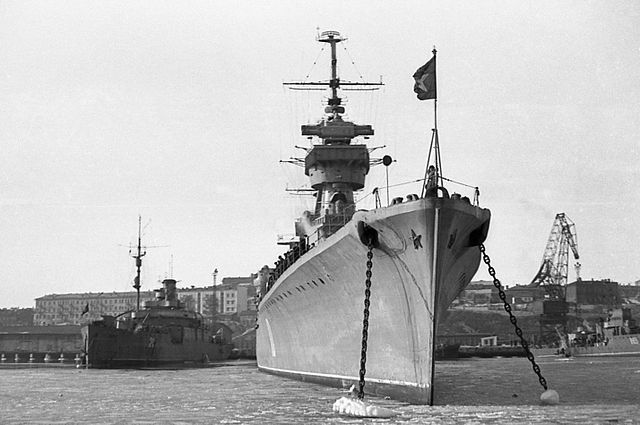
Admiral Lazarev (Адмирал Лазарев) named after Mikhail Petrovich Lazarev (admiral and explorer) was from Admiralty Shipyard, laid down in 6 February 1951, launched on 29 June 1952 and completed on 30 December 1952. On 18 February 1954, she entered the 8th brigade, and by 24 December 1955, transferred to the Baltic Fleet. Then on 27 February 1956, to the Northern Fleet. She took the Northern Sea Route from Severomorsk to the Far East then and on 22 October 1956, officially transferred to Pacific Fleet. On 26 March 1963, she was decommissioned, mothballed at Sovetskaya Gavan.
On 18 March 1972, she was reactivated and from 18 September 1980 to February 3, 1986, she was overhauled at Dalzavod, Vladivostok. On 12 October 1986, she was decommissioned, stricken on 11 February 1988, dold for BU in 1991, in India.
 Dzerzhinsky
Dzerzhinsky
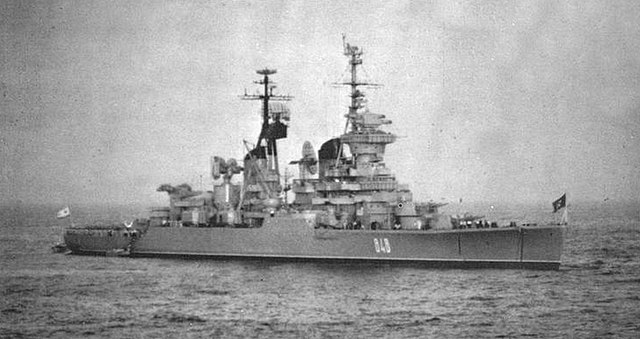
Dzerzhinsky (Дзержинский) was named after revolutionary and head of the first Soviet secret police Felix Edmundovich Dzerzhinsky. Built at Nikolayev, she was laid down on 31 December 1948, launched on 31 August 1950 and completed 18 August 1952. On 30 August 1952, she entered the Red Banner Black Sea Fleet. By fall 1955, she was transformed as a hybrid cruiser with M-2 anti-aircraft missile in place of X turret, complete with missile storage below. In February 1956, Project 70E conversion was approved by the Commander-in-Chief and modernization took place between 15 October 1957 and 24 December 1958, at Sevmorzavod, Sevastopol under Chief designer of the project K. I. Troshkov. Her aft rangefinder post and eight 37 mm V-11 guns plus torpedoes were removed. The twin SM-64 launcher was stabilized and reloaded by a barillet of10 V-753 ready missiles, plus a Corvette control system and Kaktus, Razliv radars. Three decks were cut with a 3.3 m (11 ft) structure erected to house these.
On 3 August 1961, she was reclassified as training ship and from 20 to 26 August 1964, visited Constanța.
In April 1967 she visited Split, Port Said in 10-14 July, and made tow war zone deployments from 5 to 30 June 1967 and from 5 to 24 October 1973, assisting the Egyptian Armed Forces for the Six-Day War and Yom Kippur Wars. From 9 to 12 August 1969, she visited Varna and by October 1969, Alexandria then on 26-30 April 1971, Le Havre. On 14 to 18 December 1971, Latakia. By March 1976, she visited Tartus and in April Split. On 30 June to 4 July 1977, Tunisia. From 20 to 25 October 1978, Greece, and Piraeus and on 16-20 November 1978 she was in Istanbul.
She was decommissioned on 19 February 1980, mothballed in Sevastopol. On 12 October 1988, she was, stricken, crew disbanded on 9 December 1988, transferred to the disposal unit and sold for BU but scrapped at Inkerman.
 Admiral Nakhimov
Admiral Nakhimov
Admiral Nakhimov (Адмирал Нахимов) was from Nikolayev shipyard. She was laid down on 27 June 1950, launched on 29 June 1951 and completed on 27 March 1953. She was never really fully completed and instead was rearmed as a guided missile trials ship in the late 1950s, then a target ship in 1961. On 8 February 1953, though, she joined the Black Sea Fleet and was reequipped according to Project 67EP with the Quiver missile system, single KSS launcher for experimental purposes at the Feodosiya range. She fired on old ships, and later at the compartment of the unfinished battlecruiser Stalingrad (Project 82). The Quiver complex was not adopted for service for various reasons, economical, tactical and political. On 28 July 1960, she was decommissioned and placed on the disposal list. In June 1961, she was used as target by the destoryer Prozorliviy, not repaired and instead, BU at Glavvtorchermet, Sevastopol. Her boiler was sent to the Instrument-Making Institute (currently Sevastopol State University) in 1964.
 Mikhail Kutuzov
Mikhail Kutuzov
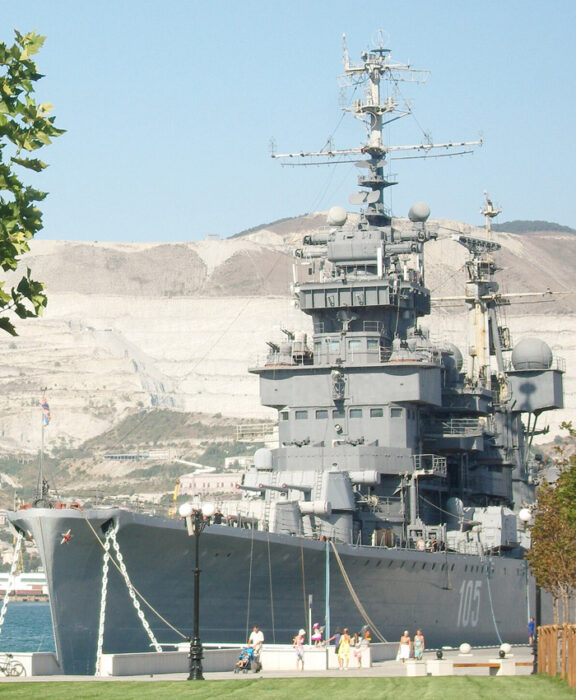
Mikhail Kutuzov (Михаил Кутузов) after the field marshal Mikhail Illarionovich Kutuzov. She was from the Nikolayev shipyard, laid down on 23 February 1951, launched on 29 November 1952 and completed 30 February 1954. Mikhail Kutuzov joined the Black Sea Fleet on 31 January 1955. Logs not published for her career. Searching in Russian sources.
Instead of scrapping after she was decommissioned in 2000 (mothballed since 1989), she became a Museum ship at Novorossiysk, still here today. She was opened to the public after transformations over two years for various exhibits on 28 July 2002. On 1 October 2012 she was part of the Central Naval Museum. Full gallery.
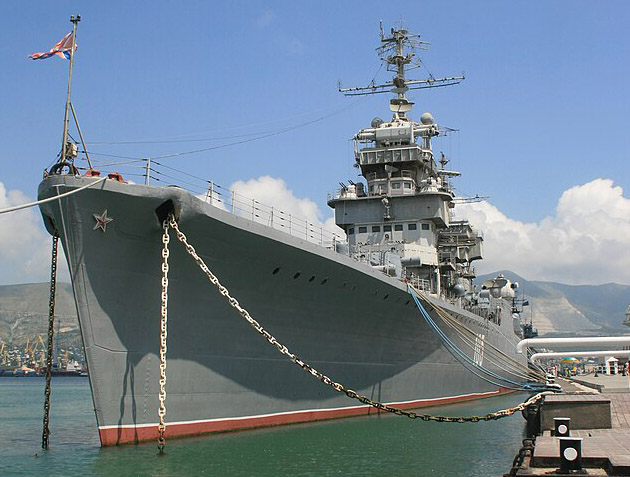
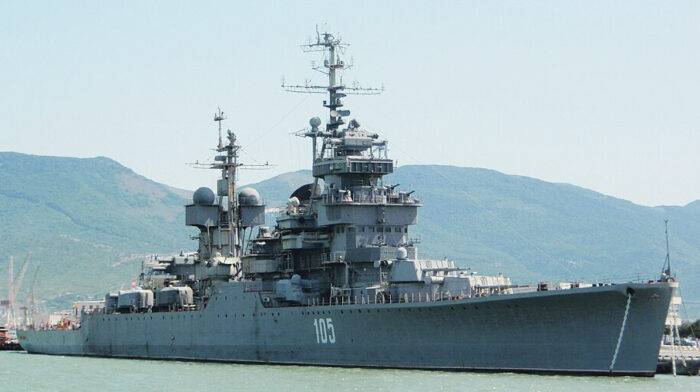
 Oktyabrskaya Revolyutsia
Oktyabrskaya Revolyutsia
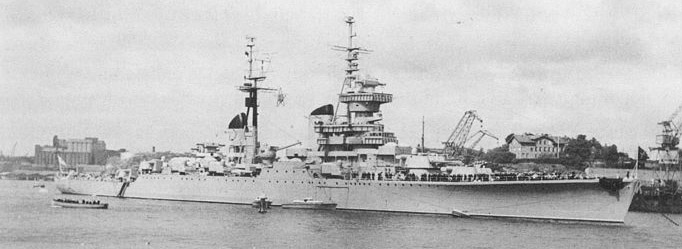
Oktyabrskaya Revolyutsia (ex-Molotovsk) named after the october revolution was from Severodvinsk shipyard, laid down on 15 July 1952, launched on 25 May 1954 and completed on 30 November 1954.
On 18 February 1954, she joined the Northern Fleet as Molotovsk. On 3-7 August 1956, she visited Oslo and on 8-12 August, Gothenburg. On 3 August 1957, she was renamed Oktyabrskaya Revolutsiya.
From 30 August to 2 September 1958, she visited Bergen and on 8-12 September, Copenhagen. She was transferred to the Baltic fleet on 16 December 1960, but on 27 March 1961, decommissioned, mothballed in Kronstadt. She was reactivated on 29 April 1966, visited Port Said in 1967, and from 16 November 1968 to 25 December 1969, modernized at Kronstadt under Project 68A.
On 8-13 May 1970, she visited Cherbourg and ob 17-23 July 1970 and from 25 September to 1 October 1972 provided assistance to the Syrian armed forces.
From 17 May to 25 June 1971, and 5-8 July and 8-12 September 1972, she did the same for Egypt. On 17-22 August 1971, she visited Copenhagen and on 20-24 July 1978, Gdynia then on 8-10 October, Rostock, again on 4-9 October 1979, Gdynia on 27-30 July 1980, Rostock again a last time on 9-14 August 1982, being decommissioned on 16 September 1987, stricken o, 11 February 1988, and scrapped until 1990 at the Glavvtorchermet base, Leningrad.
 Murmansk
Murmansk

Murmansk (Мурманск) was from Severodvinsk, laid down on 28 January 1953, launched on 24 April 1955 and completed on 22 September 1955. She joined the 2nd Cruiser Division in 1956 after basic training and certifications.
She was decommissioned late 1980s, stricken in 1992. She famously ran aground in December 1994 at Hasvik, Norway, on her way to India for scrapping. In 1994 she had been was sold to India for scrapping indeed and was on her way when she ran aground off Sørvær, apparetly towed in low visibility way too close to shore during transfer. A Norwegian took a photo of her in almost perfect condition but with a massive list the following day. It was believed that winter storms would destroy her, at least the structures but she remained intact, albeut rusting away, and at last in 2009 funding was allocated for her dismantling. Veolia and Bellona took part in the bid and were chosen to make an inspection for furthr precisions on budget. Both found a “source of radioactivity”, creating a wave of panic among locals fearing an increased incidence of cancer. It was later confirmed as luminescent paint on some indicators and switches were the cause, and no real impact. The ship still needed to be purged from fuel, PCB, and asbestos. It cannot be towed and so Scandinavian AF Decom, built a massive breakwater and cofferdam around her to dismantle the shipwreck on dry land where it rested. The cofferdam around the wreck was sealed in April 2012 and in mid-May the dock was dry, demolition started, completed in 2013.
First published 15 July 2015
Read More/Src
Books
Links
https://www.navypedia.org/ships/russia/ru_cr_sverdlov.htm
https://russianships.info/eng/warships/project_68bis.htm
http://www.ww2.dk/new/navy/2diplk.htm
Bellona and local residents demand swift removal Russia battle cruiser shipwreck in northern Norway
https://archive.ph/20120723082101/http://www.afgruppen.no/en/Environment/Aktuelt/AF-Gruppen-is-removing-the-abandoned-ship–Murmansk–/
https://web.archive.org/web/20150423175424/http://barentsobserver.com/en/nature/murmansk-demolition-final-phase
https://www.afgruppen.com/projects/miljo/the-murmansk/
http://www.navweaps.com/Weapons/WNNeth_59-53_m1942.php
https://russ-flot.narod.ru/x-0006_152_mk-3.htm
http://www.navy.su/navyarms/gun/1930-1955/b-38.htm
http://www.navweaps.com/Weapons/WTRussian_post-WWII.php
https://ru.wikipedia.org/wiki/%D0%9A%D1%80%D0%B5%D0%B9%D1%81%D0%B5%D1%80%D0%B0_%D0%BF%D1%80%D0%BE%D0%B5%D0%BA%D1%82%D0%B0_68-%D0%B1%D0%B8%D1%81
https://globalmaritimehistory.com/sverdlov_class_rn_response/

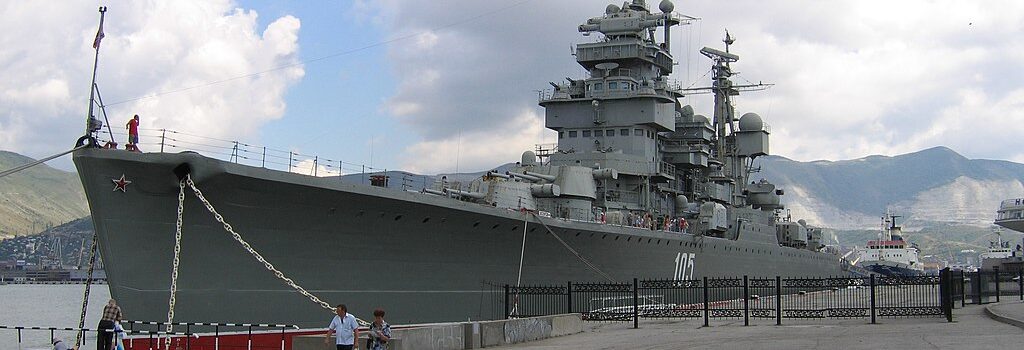


 Latest Facebook Entry -
Latest Facebook Entry -  X(Tweeter) Naval Encyclopedia's deck archive
X(Tweeter) Naval Encyclopedia's deck archive Instagram (@navalencyc)
Instagram (@navalencyc)





 French Navy
French Navy Royal Navy
Royal Navy Russian Navy
Russian Navy Armada Espanola
Armada Espanola Austrian Navy
Austrian Navy K.u.K. Kriegsmarine
K.u.K. Kriegsmarine Dansk Marine
Dansk Marine Nautiko Hellenon
Nautiko Hellenon Koninklije Marine 1870
Koninklije Marine 1870 Marinha do Brasil
Marinha do Brasil Osmanlı Donanması
Osmanlı Donanması Marina Do Peru
Marina Do Peru Marinha do Portugal
Marinha do Portugal Regia Marina 1870
Regia Marina 1870 Nihhon Kaigun 1870
Nihhon Kaigun 1870 Preußische Marine 1870
Preußische Marine 1870 Russkiy Flot 1870
Russkiy Flot 1870 Svenska marinen
Svenska marinen Søværnet
Søværnet Union Navy
Union Navy Confederate Navy
Confederate Navy Armada de Argentina
Armada de Argentina Imperial Chinese Navy
Imperial Chinese Navy Marinha do Portugal
Marinha do Portugal Mexico
Mexico Kaiserliche Marine
Kaiserliche Marine 1898 US Navy
1898 US Navy Sovietskiy Flot
Sovietskiy Flot Royal Canadian Navy
Royal Canadian Navy Royal Australian Navy
Royal Australian Navy RNZN Fleet
RNZN Fleet Chinese Navy 1937
Chinese Navy 1937 Kriegsmarine
Kriegsmarine Chilean Navy
Chilean Navy Danish Navy
Danish Navy Finnish Navy
Finnish Navy Hellenic Navy
Hellenic Navy Polish Navy
Polish Navy Romanian Navy
Romanian Navy Turkish Navy
Turkish Navy Royal Yugoslav Navy
Royal Yugoslav Navy Royal Thai Navy
Royal Thai Navy Minor Navies
Minor Navies Albania
Albania Austria
Austria Belgium
Belgium Columbia
Columbia Costa Rica
Costa Rica Cuba
Cuba Czechoslovakia
Czechoslovakia Dominican Republic
Dominican Republic Haiti
Haiti Hungary
Hungary Honduras
Honduras Estonia
Estonia Iceland
Iceland Eire
Eire Equador
Equador Iran
Iran Iraq
Iraq Latvia
Latvia Liberia
Liberia Lithuania
Lithuania Mandchukuo
Mandchukuo Morocco
Morocco Nicaragua
Nicaragua Persia
Persia San Salvador
San Salvador Sarawak
Sarawak Uruguay
Uruguay Venezuela
Venezuela Zanzibar
Zanzibar Warsaw Pact Navies
Warsaw Pact Navies Bulgaria
Bulgaria Hungary
Hungary

 Bundesmarine
Bundesmarine Dutch Navy
Dutch Navy Hellenic Navy
Hellenic Navy Marina Militare
Marina Militare Yugoslav Navy
Yugoslav Navy Chinese Navy
Chinese Navy Indian Navy
Indian Navy Indonesian Navy
Indonesian Navy JMSDF
JMSDF North Korean Navy
North Korean Navy Pakistani Navy
Pakistani Navy Philippines Navy
Philippines Navy ROKN
ROKN Rep. of Singapore Navy
Rep. of Singapore Navy Taiwanese Navy
Taiwanese Navy IDF Navy
IDF Navy Saudi Navy
Saudi Navy Royal New Zealand Navy
Royal New Zealand Navy Egyptian Navy
Egyptian Navy South African Navy
South African Navy






























 Ukrainian Navy
Ukrainian Navy dbodesign
dbodesign